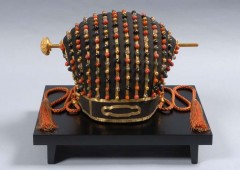2015.11.30
Pictures of ‘Spring’ reflect Japanese erotica through the ages
By David Higgins

Shunga most often came in the form of woodblock prints that people carried with them as lucky charms in their pockets.
Reflect if you can how people used to view pornography just 10 years ago, when the Internet had a dial-up connection, and we used to have to wait for pictures to slowly load onto our screens. In my lifetime alone, porn had been appreciated through color magazines and VHS tapes. Believe it or not, there was a time when it was only available in touched up black and white photos but even prior to this, erotica was painted and drawn.
The history of Japanese erotic pictures dates back all the way to the Heian period, and called ‘Shunga’, which means ‘picture of spring’; ‘spring’ being a euphemism for sex. Most shunga was executed by wood block print format, while even more rare are erotic hand-painted hand scrolls.
Both men and women of all classes enjoyed the Shunga, which were surrounded by superstition and customs. It was considered a lucky charm against death for a Samurai to carry shunga, or for a merchant to carry it as protection against a fire in his warehouses and home. Literally, it was considered ‘porn in your pocket,’ a good luck charm. Considering that we all now carry smart phones in our pockets, we can deduce that to some degree we are protected and are warding off some sort of evil. It is argued that the ownership of shunga was not superstitious, but libidinous.
In almost all shunga the characters are fully clothed. This is primarily because nudity was not inherently erotic in Tokugawa Japan – people were used to seeing the opposite sex naked in communal baths. It also served an artistic purpose; it helped the reader identify courtesans and foreigners, the prints often contained symbolic meaning, and it drew attention to the parts of the body that were the focus of the action.

Shunga is experiencing somewhat a renaissance with exhibitions held in art museums throughout the world including in Europe and the U.S.
Shunga couples were often shown in nonrealistic positions with exaggerated genitalia. Explanations for this include increased visibility of the sexually explicit content, artistic interest and psychological impact: that is, the genitalia was interpreted as a ‘second face,’ expressing the primal passions that the everyday person face, and is obligated to conceal. Therefore the heads are placed unnaturally close and in awkward positions.
Both painted hand scrolls and illustrated erotic books (empon) often presented an unrelated sequence of sexual tableaux, rather than a structured narrative. A whole variety of possibilities were shown — men seduce women, women seduce men; men and women cheating on each other; all ages from virginal teenagers to old married couples; even octopus were occasionally featured.
The introduction of Western culture and technologies at the beginning of the Meiji era (1868–1912), particularly the importation of photo-reproduction techniques, had serious consequences for shunga. For a time, woodblock printing continued to be used, but figures began to appear in prints wearing Western clothing and hairstyles. Eventually, shunga could no longer compete with erotic photography, leading to its decline.
In my opinion, after perusing through some old Shunga prints on the internet I understand why Shunga was let go, and western-style pornography became popular. But some Shunga fanatics have maintained their obsession for these images depicting simpler times and hold a deep appreciation for the art and history that these often odd compositions are sharing with us. Maybe there is something to be learned from them.


 2024.07.07
2024.07.07 2024.07.02
2024.07.02 2024.06.11
2024.06.11 2024.06.03
2024.06.03 2024.05.02
2024.05.02 2024.04.26
2024.04.26 2024.04.04
2024.04.04 2024.04.02
2024.04.02 2024.03.03
2024.03.03 2024.02.26
2024.02.26






